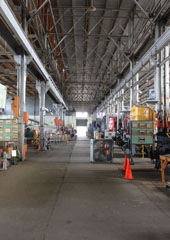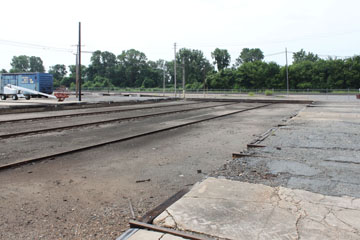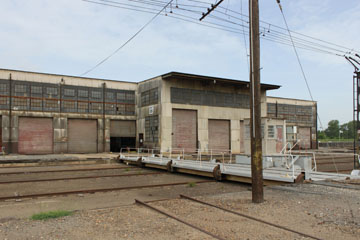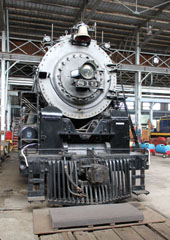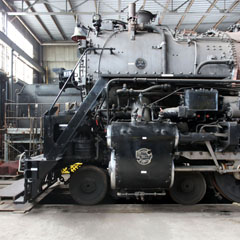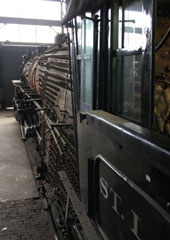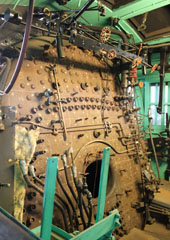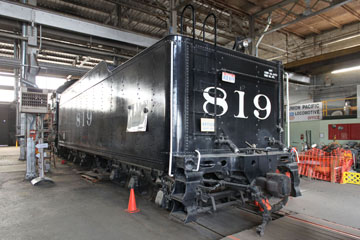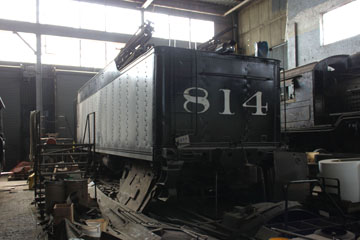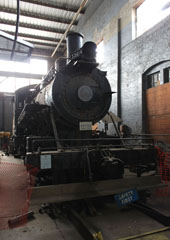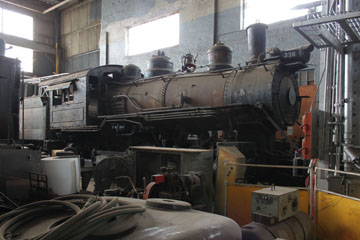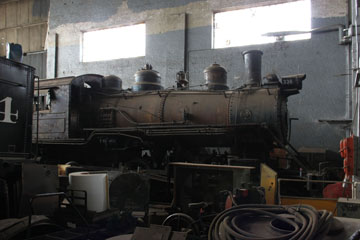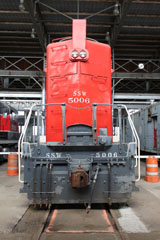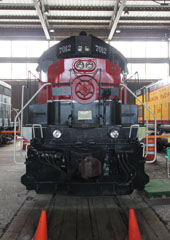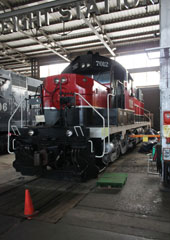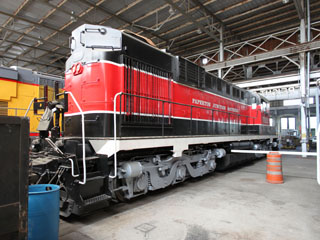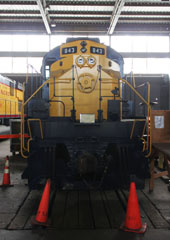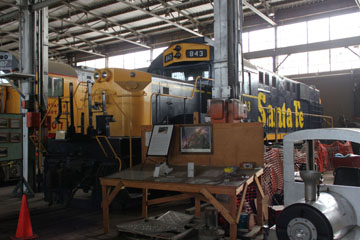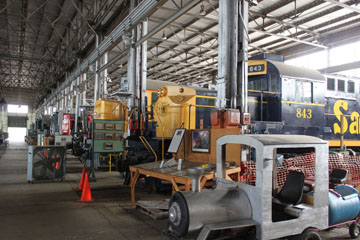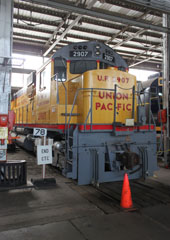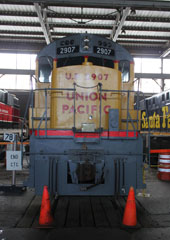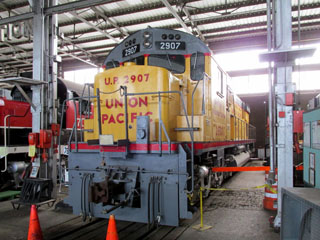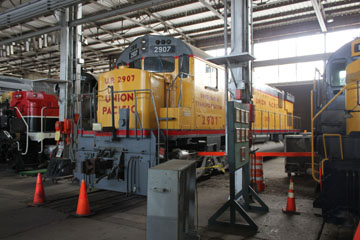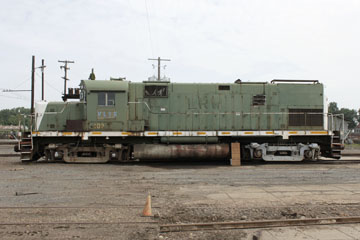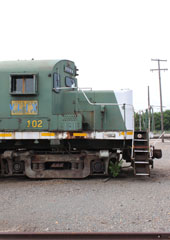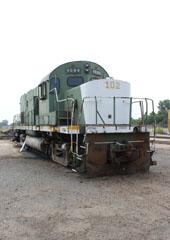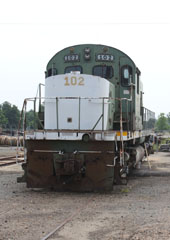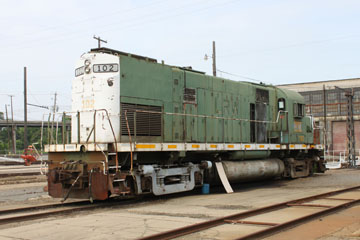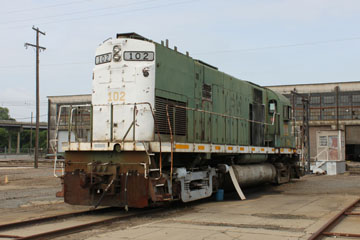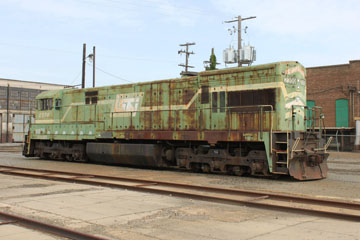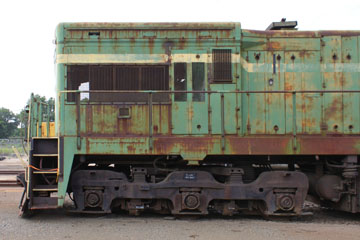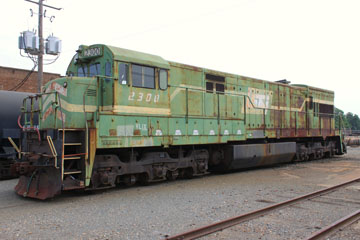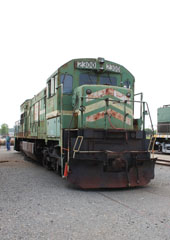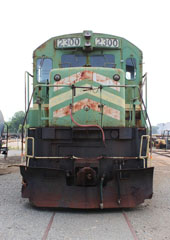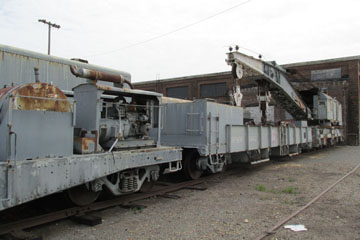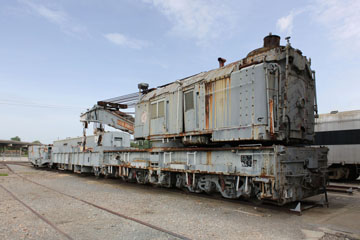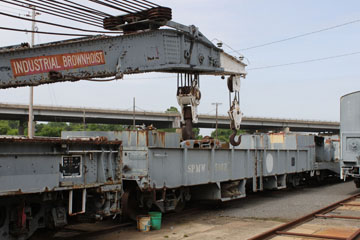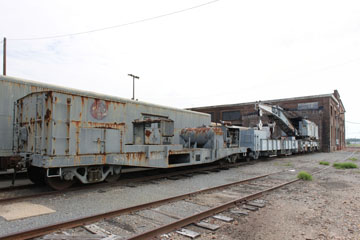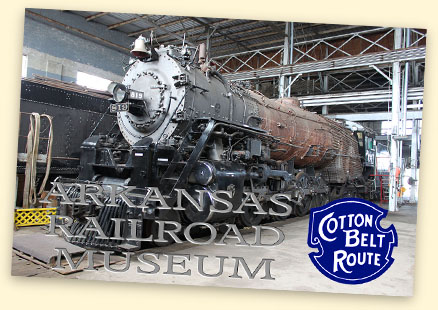

The Arkansas Railroad Museum is on Port Road in Pine Bluff, AR, at the former St. Louis Southwestern Railway (Cotton Belt) shops. This was the main heavy repair and erection shop for SSW during the steam era containing heavy repair equipment such as pits, overhead cranes and tools for servicing large railroad equipment.
The museum owes its existence to efforts in the 1980s to restore SSW #819. The Cotton Belt had agreed to house the locomotive at the shops while restoration work was carried out by the Cotton Belt Historical Society, and this brought many visitors to the building. Others began to bring items to donate to the society, and it soon became obvious that the project was growing into more than a restored steam engine. The name Arkansas Railroad Museum was adopted and the museum is still operated by the Cotton Belt Rail Historical Society. The building has over 70,000 sq ft of floor space and seventeen tracks, and houses two display rooms.
The Museum is open 9.00am to 2.00pm, Monday to Saturday, though extreme temperatures can affect operating hours as the shops are neither heated nor air conditioned. Admission is free, although donations are welcomed.

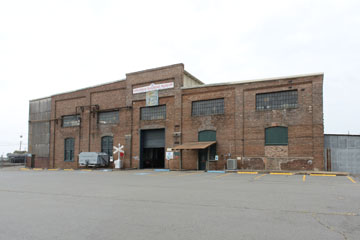
Above, the main entrance to the shops. The best time to see the exhibits outside is the first weekend in April (unless that weekend is Easter) when the Museum has its annual show. Many of the exhibits are taken outside and tables are set up inside the museum for vendors.
Below, a map on display inside the museum
shows the extent of the Cotton Belt works. The shops, just above the roundhouse are one of only two of the original buildings on the site to have survived.
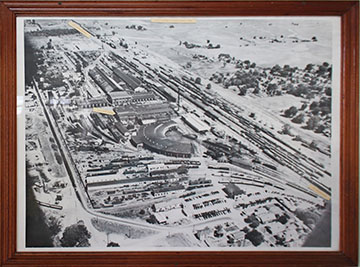
Left and below, inside the shops. Right, on the east side of the shops, the transfer table is still operable and occasionally used to relocate equipment.
Bottom, the second surviving building is occupied by a private company making railroad truck wheels.


The Cotton Belt initially bought ten Northern type (4-8-4) locomotives classified L1 from the
Baldwin Locomotive Works in Eddystone, PA, in 1930 (#800-#809). Seven years later, five more were built at the railroad’s shops in Pine Bluff, AR, (#810–814) to slightly different specifications. In 1942, the Cotton Belt then petitioned the War Production Board for approval to buy five EMD FT diesel locomotives for their growing freight business but were, instead, given approval to produce five more L1s (#815-#819).
Work on the final batch of L1s began on 2nd
June 1942, but delays in delivery of the boilers
from Baldwin until mid-December meant that the last of the five locomotives, #819, didn’t start in active service until 8th February 1943. It cost $143,607, and was the last locomotive produced in Arkansas.
Although everything else remained the same,
#814-#819 weighed 425,500 lbs, 3,000 lbs more
than the earlier L1s. Weight on the drivers rose from 242,500 lbs to 248,000 lbs. With an 88.3 sq ft grate and 469 sq ft firebox, the total heating
surface was 6,690 sq ft, including 1,962 sq ft superheating.
All twenty L1s had a 45’ engine wheelbase and 18’ 9” driver wheelbase with 70” drivers, Walschaert valve gear and
26” x 30” cylinders. Operating at a boiler pressure of 250 psi, they delivered 51,564 lbs tractive
effort.
Unlike the Baldwin built L1s, however, #814-#819 had roller bearings on all axles and Boxpok drivers.

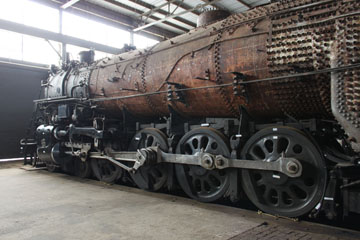
The superheater lost 98 sq ft of heating surface compared to the earlier engines, probably by eliminating elements from a few 3½" flues, as the tube and flue counts remained the same at fifty-two and two hundred respectively.
As they were built during WW II, some materials were in short supply. The Cotton Belt emblems, which would have normally been made of brass, were therefore made of steel to save brass for the war effort. Decorative emblems, numbers, etc., were also made of steel and chromium plating was eliminated entirely.
#819 had run more than 804,000 miles during its 10½ years service when retired in 1953.
In 1955, the Cotton Belt donated #819 to the City
of Pine Bluff, and a group of volunteers moved
the locomotive to Townsend Park. The Cotton
Belt loaned materials and Cotton Belt and
Missouri Pacific employees contributed their labour to build a temporary spur to the park. The locomotive sat on display there until moved to Oakland Park in 1960. Five years later, a steel shed was erected to protect the locomotive from the elements.
For the next few years, #819 was looked after by visits from long-time railfan James Norris, whose father had taken the locomotive out for its first run in 1943.
Norris died in 1970 and, by 1983, #819 was in a very dilapidated state, covered in graffiti with many of its parts removed, including its bell, whistle, Cotton Belt emblems and many of the gauges. At that point, a sub-committee of the Pine Bluff Chamber of Commerce's Publicity & Tourism Department was established to get #819 rejuvenated and relocated.
The Cotton Belt agreed the locomotive and tender could be transported from the park back to the shops for the work.
Although ownership of #819 was retained by the city, restoration was the responsibility of "Project 819", an all-volunteer effort by the Arkansas Railroad Club and the Cotton Belt Rail Historical Society. The project leased the space at the Cotton Belt shops to work on the restoration, and seven volunteer groups worked six days a week more than 35,000 man-hours at a cost of over $140,000 over the next two years.
The engine was subsequently partially disassembled to undergo a Federal Railroad Administration inspection but then metal prices skyrocketed, various emergency repairs were needed at the museum and available funds to replace necessary parts were no longer sufficient to put the locomotive back in service. #819 was listed on the National Register of Historic Places in 2003.
Below, SSW #814’s tender was used as an auxiliary, giving #819 a range of about 100 miles between water stops.
On 6th April 1986, #819 moved out of the Cotton Belt yard and, on 26th April 1986, it pulled into Fordyce on its first trip out of Pine Bluff in thirty-one years.
During the summer of 1986, film crews came to Pine Bluff for the production of the movie End of the Line in which #819 played a role. For the next seven years, it travelled on numerous excursions, including a trip to the 1990 NRHS convention in St. Louis, where it stood at Union Station with Union Pacific Railroad #844, Frisco #1522 and Norfolk & Western #1218.

Ten of these Mogul
type (2-6-0)
locomotives were built by Burnham, Williams & Co., an early incarnation of the Baldwin Locomotive Works in Philadelphia, PA, (#331-#340).
The first five were delivered in 1906, the last five in 1909.
With Stephenson valve gear and 19” x 26” cylinders, #336 weighs 159,000 lbs, 138,000
lbs on its 51” drivers. With a 28.8 sq ft grate, 175 sq ft firebox and total heating surface of 1,870 sq ft, it operated at 200 psi delivering 31,287 lbs tractive effort.
#336 was retired in
1947 and sold to Meriwether Gravel in Lewisville, AR. Later bought by the Gifford Hill Company, it worked in a gravel pit until 1963. It was then placed in a park in Lewisville. In August 1994, it was donated to the Cotton Belt Rail Historical Society.

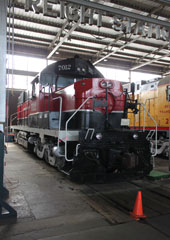

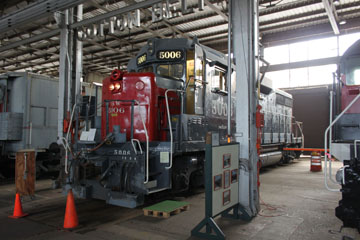
Nine hundred and eight GP30s were built by EMD between 1961 and 1963, all for US railroads. Forty cabless B units were also built for the Union Pacific, and two additional cab units were built by General Motors Diesel (GMD) in London, Ontario for the Canadian Pacific.
Powered by a V16 EMD 567D3 with a GM-D22 generator and four GM-D57 traction motors, the GP30 could deliver 60,500 lbs starting tractive effort at 25% and 50,000 lbs continuous tractive effort at 9.3 mph. At 56' 2" in length, it weighs 260,000 lbs and had a top speed of 65 mph.

Conceived to head off competition from GE's U25B, at 2,500 hp then the highest hp four axle diesel-electric in the US, the GP30 updated elements of the GP20 but managed to get an extra 250 hp out of the 567 series engine.
Ten GP30s were delivered to the Cotton Belt in 1963 (#5000-#5009) identical to eighteen built for the Southern Pacific the same year. The SP had gained control of the Cotton Belt in 1932 and the two companies operated closely. The SSW GP30s were used with SP GP30s on freights between California and Texas.

RSD-12s used a 12-cycle 251B prime mover producing 1800 hp, with a GE-GT586 generator powering four GE 752 traction motors. Weighing 350,000 lbs and 58’ 1” in length, they developed 81,250 lbs starting tractive effort at 25% and continuous tractive effort of 78,500 lbs at 6 mph with a top speed of 65 mph.
While powered with the newer and more reliable 251 series engine, the SP's RSD-12s contained some components from the traded-in RSD 5s, such as the six wheel "tri-mount" trucks.
The SD-12s spent the majority of their SP working life in local freight and switching service. #7012 was renumbered #2962 in 1966 and sold to the Kerr-McGee Chemical Company. It was then sold to the Purdy Metals Company and on to the West Tennessee Railroad in 1993, where it was renumbered #1854. It was subsequently renumbered #2054 and sold to Vintage Locomotives Incorporated, then sold as Paperton Junction Southern Railway #7012. It is on loan to the museum.
Built by Alco in 1961 as Southern Pacific #7012, this is one of twenty-one RSD-12 units delivered to the railroad that year.
The purchase was a result of the company's dissatisfaction with the performance of its fleet of Alco RSD-5 units and their 244 series engines. With Alco unable to offer any improvements to
the 244 engine, and despite the fact that its
oldest RSD-5s were only about seven years old,
the SP struck a deal to trade in twenty-one of its RSD-5s for credit towards the purchase of the
RSD-12s.

With a 2,400 hp Alco 4-cycle Model 251B V16 prime mover powering six GE 752 traction motors, it weighs 335,000 lbs and is 66' 7" long. Delivering 79,500 lbs continuous tractive effort at 12 mph, it had a top speed of 65 mph. The three-axle Trimount trucks had an asymmetrical axle spacing because of the positioning of the traction motors, but allowed higher tractive effort at lower speeds than a similar four-motor design.
You can see other RSD-15s on the Ogden Union Station and Illinois Railway Museum Shed pages of this website.
Alco built this RSD-15 unit in 1960 for the ATSF
as #843. In 1970, it was renumbered #9843. By
June 1974 it was on the San Bernardino, CA,
dead line. The following year, it was sold to the Precision National Corporation. It then went, in succession, to the Squaw Creek Coal Company, Indiana Hi-Rail Wabash & Ohio, and the Mauwmee & Western Railroad. A private individual then purchased the unit, which is on loan to the museum.
Alco built seventy-five RSD-15s, all for US railroads from 1956 to 1960.

#2907 was one of ten C-630s (#2900-#2009) built for the UP. All were later sold to the Duluth, Missabe & Iron Range, where #2907 was renumbered #907. In 1976, #907 was sold to Cartier Mining in Quebec and renumbered #34. It was retired in 1985, bought by the locomotive dealer Ed Bowers and is on loan to the museum.
The 69’ 6” long unit weighs 420,000 lbs with an Alco 4-cycle 251E V16 engine and GT GTA9 generator powering six GE752 traction motors. Starting tractive effort is 85,850 lbs at 25%, 79,500 lbs continuous tractive effort at 12 mph.
Alco built this 3,000 hp C-630 unit in 1966
for the Union Pacific as #2907. The C-630
was one of the Century Series diesel
electrics built by Alco between 1963 and
1972.
Seventy-seven C-630s were built from 1965 to 1968. Ten were delivered to the Norfolk & Western, the only ones designed with high short hoods that were mandated by N&W operating policy. You can see NW C-630 #1135 on the Virginia Museum of Transportation page of this website.
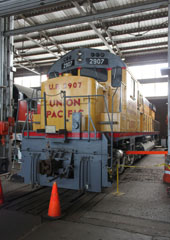
The most distinctive feature of the C-630 is its large aftercooler radiator housing above the roofline, which boosted performance when the unit was hauling a heavy load.
Three other C-630s have survived: as well as NW #1135, RDG #5308 is owned by the Reading Technical & Historical Society and another privately owned UP C-630 is stored at the Arkansas Railroad Museum. You can see other Century Series units on the Pennsylvania Railroad Museum Yard page of this website, the Steamtown Yard and the National Railroad Museum pages.

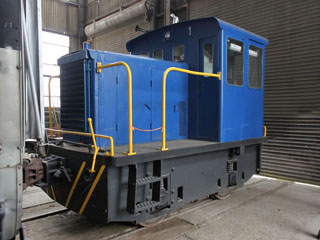

This GE 25 Ton diesel electric switcher was built some time between 1940 and 1943. Not much is known about its early life but, from about 1970, it worked at Wabash Alloys in Haskell, AR. After it became surplus to the company's needs, it was donated to the museum in March 2003.
The 25 Ton model was the smallest locomotive in the GE range of switchers produced in the 1940s and 1950s. Designed for the small industrial use it delivered 15,000 lb tractive effort.

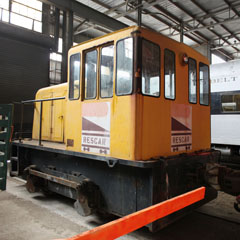
Another GE 25 Ton diesel electric switcher, #210 was built in 1953 and went to work for Central Texas Gravel. It is not known when but, at some stage, it moved to another gravel supplier, Gifford-Hill & Co., working first in Shreveport, LA, and then at Eagle Mills, AR.
The locomotive was then sold to Rescar in Cicero, IL, a company. providing maintenance services, mechanical repairs, painting and cleaning to other owners of railroad equipment. In 1997, it was transferred from Cicero to Longview, TX.
In 2004, #210 was sold to Power Source Supply, a supplier of locomotives and parts to other railroads. Power Source Supply never used the locomotive and sold it to a private individual in 2005. It arrived at the Arkansas Railroad Museum in 2005.

They deliver starting tractive effort of
57,200 lbs at 25% and 38,000 lbs continuous tractive effort at 8 mph with a top speed of 70 mph.
You can see other
C-420s on the Steamtown Yard page of this website and the GLLX #850 page.
Built by Alco as #1306, this C-420 unit was one of ten delivered to the Louisville & Nashville in 1966 (#1306-#1315). It was sold to the Little Rock & Western in 1981, where it became #102. In 2009, it was bought by Vintage Locomotives Inc., in Pearland, TX, a company owned by Ed Bowers and is on loan to the museum.
One hundred and thirty-one C-420 units were built between 1963 and 1968. Weighing 250,000 lbs and 60' 3" long, their 2,000 hp 251C V12 prime movers drive a GE GT581 generator to power four GE 752 traction motors.

The U23C has a GE FDL-12 4-cycle, V-Type prime mover and GT598 generator.
Weighing 348,000 lbs and 67’ 3” long, the
unit delivers starting tractive effort of
85,800 lbs at 25% and 90,000 lbs continuous tractive effort at 10.7 mph.
This is the first U23C unit outshopped from GE's Erie, PA, works in 1968, one of five bought by the Lake Superior and Ishpeming. It was bought by an individual and is now on loan to the Museum. It is the sole surviving GE U23C.
Designed to compete with EMD's SD38 and SD39 series, the U23C was meant for heavy drag and hump work where speed was not a priority. Seventy-three were built from 1969 to 1970 including twenty for export to Brazil. Another one hundred and fifty were built by GE de Brazil from 1972 to 1976, some with kits supplied by GE.

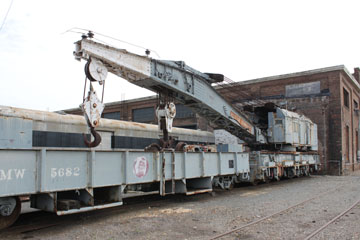

Built by Industrial Brownhoist in Bay City, MI, in 1940, this is the only surviving steam-powered relief crane in the world. St. Louis Southwestern #96005 became part of the Union Pacific roster when the company consolidated its ownership, although it was not relettered, and it retired in 1996 still wearing its SSW #96005 livery.
The crane ran a six car consist when deployed to derailment sites, consisting of Boom Car SSWMW #5682, Kitchen Car SSWMW #94129, Generator Flat SSWMW #98501, Tool Car SSWMW #96216 and Crew Sleeper SSWMW #96209.


